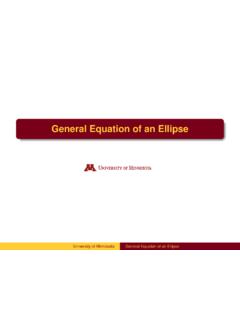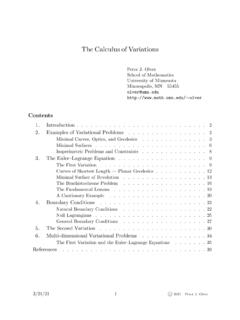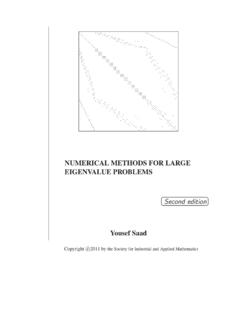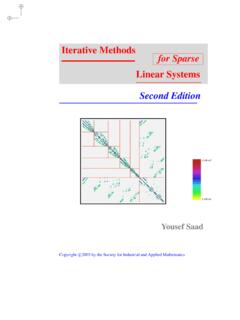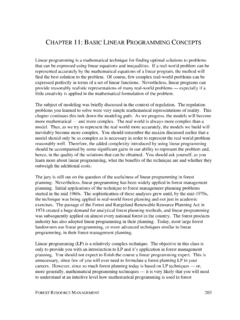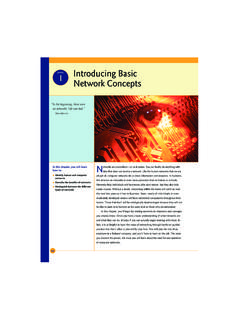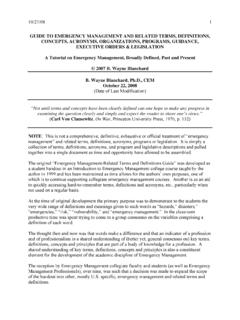Transcription of Association Analysis: Basic Concepts and Algorithms
1 K 5. Association analysis : Basic Concepts and Algorithms Many business enterprises accumulate large quantities of data from their day- to-day operations. For example, huge amounts of customer purchase data are k collected daily at the checkout counters of grocery stores. Table gives an k example of such data, commonly known as market basket transactions. Each row in this table corresponds to a transaction, which contains a unique identi er labeled T ID and a set of items bought by a given customer. Retailers are interested in analyzing the data to learn about the purchasing behavior of their customers. Such valuable information can be used to support a vari- ety of business-related applications such as marketing promotions, inventory management, and customer relationship management. This chapter presents a methodology known as Association analysis , which is useful for discovering interesting relationships hidden in large data sets.
2 The uncovered relationships can be represented in the form of sets of items present in many transactions, which are known as frequent itemsets, Table An example of market basket transactions. T ID Items 1 {Bread, Milk}. 2 {Bread, Diapers, Beer, Eggs}. 3 {Milk, Diapers, Beer, Cola}. 4 {Bread, Milk, Diapers, Beer}. 5 {Bread, Milk, Diapers, Cola}. k k 358 Chapter 5 Association analysis or Association rules, that represent relationships between two itemsets. For example, the following rule can be extracted from the data set shown in Table : {Diapers} {Beer}. The rule suggests a relationship between the sale of diapers and beer because many customers who buy diapers also buy beer. Retailers can use these types of rules to help them identify new opportunities for cross-selling their products to the customers. Besides market basket data, Association analysis is also applicable to data from other application domains such as bioinformatics, medical diagnosis, web mining, and scienti c data analysis .
3 In the analysis of Earth science data, for example, Association patterns may reveal interesting connections among the ocean, land, and atmospheric processes. Such information may help Earth scientists develop a better understanding of how the di erent elements of the Earth system interact with each other. Even though the techniques presented here are generally applicable to a wider variety of data sets, for illustrative purposes, our discussion will focus mainly on market basket data. There are two key issues that need to be addressed when applying associ- ation analysis to market basket data. First, discovering patterns from a large k k transaction data set can be computationally expensive. Second, some of the discovered patterns may be spurious (happen simply by chance) and even for non-spurious patterns, some are more interesting than others. The remainder of this chapter is organized around these two issues.
4 The rst part of the chapter is devoted to explaining the Basic Concepts of Association analysis and the Algorithms used to e ciently mine such patterns. The second part of the chapter deals with the issue of evaluating the discovered patterns in order to help prevent the generation of spurious results and to rank the patterns in terms of some interestingness measure. Preliminaries This section reviews the Basic terminology used in Association analysis and presents a formal description of the task. Binary Representation Market basket data can be represented in a binary format as shown in Table , where each row corresponds to a transaction and each column corresponds to an item. An item can be treated as a binary variable whose value is one if the item is present in a transaction and zero otherwise. Because the presence of an item in a transaction is often considered k k Preliminaries 359.
5 Table A binary 0/1 representation of market basket data. TID Bread Milk Diapers Beer Eggs Cola 1 1 1 0 0 0 0. 2 1 0 1 1 1 0. 3 0 1 1 1 0 1. 4 1 1 1 1 0 0. 5 1 1 1 0 0 1. more important than its absence, an item is an asymmetric binary variable. This representation is a simplistic view of real market basket data because it ignores important aspects of the data such as the quantity of items sold or the price paid to purchase them. Methods for handling such non-binary data will be explained in Chapter 6. Itemset and Support Count Let I = {i1 , i2 , .. , id } be the set of all items in a market basket data and T = {t1 , t2 , .. , tN } be the set of all transactions. Each transaction ti contains a subset of items chosen from I. In Association analysis , a collection of zero or more items is termed an itemset. If an itemset k contains k items, it is called a k-itemset. For instance, {Beer, Diapers, Milk} k is an example of a 3-itemset.
6 The null (or empty) set is an itemset that does not contain any items. A transaction tj is said to contain an itemset X if X is a subset of tj . For example, the second transaction shown in Table contains the itemset {Bread, Diapers} but not {Bread, Milk}. An important property of an itemset is its support count, which refers to the number of transactions that contain a particular itemset. Mathematically, the support count, (X), for an itemset X can be stated as follows: % %. (X) = %{ti |X ti , ti T }%, where the symbol | | denotes the number of elements in a set. In the data set shown in Table , the support count for {Beer, Diapers, Milk} is equal to two because there are only two transactions that contain all three items. Often, the property of interest is the support, which is fraction of trans- actions in which an itemset occurs: s(X) = (X)/N. An itemset X is called frequent if s(X) is greater than some user-de ned threshold, minsup.
7 K k 360 Chapter 5 Association analysis Association Rule An Association rule is an implication expression of the form X Y , where X and Y are disjoint itemsets, , X Y = . The strength of an Association rule can be measured in terms of its support and con dence. Support determines how often a rule is applicable to a given data set, while con dence determines how frequently items in Y appear in transactions that contain X. The formal de nitions of these metrics are (X Y ). Support, s(X Y ) = ; ( ). N. (X Y ). Con dence, c(X Y ) = . ( ). (X). Example Consider the rule {Milk, Diapers} {Beer}. Because the support count for {Milk, Diapers, Beer} is 2 and the total number of transac- tions is 5, the rule's support is 2/5 = The rule's con dence is obtained by dividing the support count for {Milk, Diapers, Beer} by the support count for {Milk, Diapers}. Since there are 3 transactions that contain milk and diapers, the con dence for this rule is 2/3 = k Why Use Support and Con dence?
8 Support is an important measure k because a rule that has very low support might occur simply by chance. Also, from a business perspective a low support rule is unlikely to be interesting because it might not be pro table to promote items that customers seldom buy together (with the exception of the situation described in Section ). For these reasons, we are interested in nding rules whose support is greater than some user-de ned threshold. As will be shown in Section , support also has a desirable property that can be exploited for the e cient discovery of Association rules. Con dence, on the other hand, measures the reliability of the inference made by a rule. For a given rule X Y , the higher the con dence, the more likely it is for Y to be present in transactions that contain X. Con dence also provides an estimate of the conditional probability of Y given X. Association analysis results should be interpreted with caution.
9 The infer- ence made by an Association rule does not necessarily imply causality. Instead, it can sometimes suggest a strong co-occurrence relationship between items in the antecedent and consequent of the rule. Causality, on the other hand, requires knowledge about which attributes in the data capture cause and e ect, and typically involves relationships occurring over time ( , greenhouse gas emissions lead to global warming). See Section for additional discussion. k k Preliminaries 361. Formulation of the Association Rule Mining Problem The associa- tion rule mining problem can be formally stated as follows: De nition ( Association Rule Discovery). Given a set of transactions T , nd all the rules having support minsup and con dence minconf , where minsup and minconf are the corresponding support and con dence thresholds. A brute-force approach for mining Association rules is to compute the support and con dence for every possible rule.
10 This approach is prohibitively expensive because there are exponentially many rules that can be extracted from a data set. More speci cally, assuming that neither the left nor the right- hand side of the rule is an empty set, the total number of possible rules, R, extracted from a data set that contains d items is R = 3d 2d+1 + 1. ( ). The proof for this equation is left as an exercise to the readers (see Exercise 5 on page 440). Even for the small data set shown in Table , this approach requires us to compute the support and con dence for 36 27 + 1 = 602 rules. k More than 80% of the rules are discarded after applying minsup = 20% and k minconf = 50%, thus wasting most of the computations. To avoid performing needless computations, it would be useful to prune the rules early without having to compute their support and con dence values. An initial step toward improving the performance of Association rule min- ing Algorithms is to decouple the support and con dence requirements.


